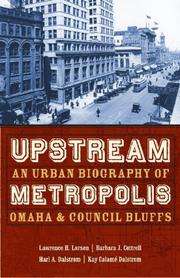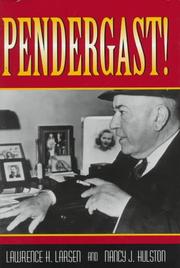| Listing 1 - 10 of 10 |
Sort by
|

ISBN: 1280823674 9786610823673 080320602X 9780803206021 9781280823671 9780803280021 0803280025 6610823677 9780803207554 0803207557 Year: 2007 Publisher: Lincoln : University of Nebraska Press,
Abstract | Keywords | Export | Availability | Bookmark
 Loading...
Loading...Choose an application
- Reference Manager
- EndNote
- RefWorks (Direct export to RefWorks)
From its birth as interdependent towns on the Missouri River frontier to its emergence as a metropolis straddling two states, Omaha-Council Bluffs has been one of the great urban construction projects in the nation's history. Upstream Metropolis provides the first comprehensive history of this unique urban region that ranks 60th among the 370 major metropolitan areas in the United States.
City and town life. --- History. --- Omaha (Neb.) -- History. --- Urbanization. --- City and town life --- Urbanization --- United States Local History --- Regions & Countries - Americas --- History & Archaeology --- Cities and towns, Movement to --- Urban development --- Urban systems --- Cities and towns --- Social history --- Sociology, Rural --- Sociology, Urban --- Urban policy --- Rural-urban migration --- City life --- Town life --- Urban life --- History --- Omaha (Neb.) --- Council Bluffs (Iowa) --- Social conditions. --- Omaha City (Neb.) --- City of Omaha (Neb.) --- Council Bluffs, Iowa --- Council Bluffs City (Iowa) --- Kanesville (Iowa)
Book
ISBN: 0813163684 9780813163680 0813153476 9780813153476 0813194741 Year: 1985 Publisher: Lexington, Kentucky : The University Press of Kentucky,
Abstract | Keywords | Export | Availability | Bookmark
 Loading...
Loading...Choose an application
- Reference Manager
- EndNote
- RefWorks (Direct export to RefWorks)
Operating under an outmoded system of urban development and faced by the vicissitudes of the Civil War and Reconstruction, southerners in the nineteenth century built a network of cities that met the needs of their society. In this pioneering exploration of that intricate story, Lawrence H. Larsen shows that in the antebellum period, southern entrepreneurs built cities in layers to facilitate the movement of cotton. First came the colonial cities, followed by those of the piedmont, the New West, the Gulf Coast, and the interior. By the Civil War, cotton could move by a combination of road, rai
Urbanization --- Cities and towns, Movement to --- Urban development --- Urban systems --- Cities and towns --- Social history --- Sociology, Rural --- Sociology, Urban --- Urban policy --- Rural-urban migration --- History
Book
ISBN: 9780813163673 0813163676 081315345X 9780813153452 0813194733 9780813194738 Year: 1990 Publisher: Lexington, Kentucky : The University Press of Kentucky,
Abstract | Keywords | Export | Availability | Bookmark
 Loading...
Loading...Choose an application
- Reference Manager
- EndNote
- RefWorks (Direct export to RefWorks)
In this panoramic survey of urbanization in the American South from its beginnings in the colonial period through the ""Sunbelt"" era of today, Lawrence Larsen examines both the ways in which southern urbanization has paralleled that of other regions and the distinctive marks of ""southernness"" in the historical process.Larsen is the first historian to show that southern cities developed in ""layers"" spreading ever westward in response to the expanding transportation needs of the Cotton Kingdom. Yet in other respects, southern cities developed in much the same way as cities elsewhere in Amer
Cities and towns --- Urbanization --- Global cities --- Municipalities --- Towns --- Urban areas --- Urban systems --- Human settlements --- Sociology, Urban --- Cities and towns, Movement to --- Urban development --- Social history --- Sociology, Rural --- Urban policy --- Rural-urban migration --- History.
Book
ISBN: 0700631062 0700601686 0700631615 Year: 1978 Publisher: University Press of Kansas
Abstract | Keywords | Export | Availability | Bookmark
 Loading...
Loading...Choose an application
- Reference Manager
- EndNote
- RefWorks (Direct export to RefWorks)
Historians have largely ignored the western city; although a number of specialized studies have appeared in recent years, this volume is the first to assess the importance of the urban frontier in broad fashion. Lawrence H. Larsen studies the process of urbanization as it occurred in twentyfour major frontier towns. Cities examined are Kansas City, St. Joseph, Lincoln, Omaha, Atchison, Lawrence, Leavenworth, Topeka, Austin, Dallas, Galveston, Houston, San Antonio, Denver, Leadville, Salt Lake city, Virginia City, Portland, Los Angeles, Oakland, Sacramento, San Francisco, San Jose, and Stockton.Larsen bases his analysis of western cities and their problems on social statistics obtained from the 1880 United States Census. This census is particularly important because it represents the first time that the federal government regarded the United States as an urban nation. The author is the first scholar to do a comprehensive investigation of this important source.This volume gives an accurate portrayal of western urban life. Here are promoters and urban planners crowding as many lots as possible into tracts in the middle of vast, uninhabited valleys. Here are streets clogged with filth because of inadequate sanitation systems; people crowded together in packed quarters with only fledgling police and fire services. Here, too, is the advance of nineteenthcentury technology: gaslights, telephones, interurbans.Most important, this study dispels the misconceptions concerning the process of exploration, settlement, and growth of the urban west. City building in the American West, despite popular mythology, was not a response to geographic or climatic conditions. It was the extension of a process perfected earlier, the promotion and building of sites—no matter how undesirable—into successful localities. Uncontrolled capitalism led to disorderly development that reflected the abilities of individual entrepreneurs rather than most other factors. The result was the establishment of a society that mirrored and made the same mistakes as those made earlier in the rest of the country.
Book
ISBN: 0813103096 Year: 1990 Publisher: Lexington University Press of Kentucky
Abstract | Keywords | Export | Availability | Bookmark
 Loading...
Loading...Choose an application
- Reference Manager
- EndNote
- RefWorks (Direct export to RefWorks)

ISBN: 0826264239 9780826264237 0826201083 9780826201089 0826201245 9780826201249 0826201482 9780826201485 0826211127 9780826211125 0826204945 9780826204943 0826215432 9780826215437 Year: 2004 Publisher: Columbia University of Missouri Press
Abstract | Keywords | Export | Availability | Bookmark
 Loading...
Loading...Choose an application
- Reference Manager
- EndNote
- RefWorks (Direct export to RefWorks)

ISBN: 0826260993 9780826260994 0826211453 9780826211453 Year: 1997 Publisher: Columbia : University of Missouri Press,
Abstract | Keywords | Export | Availability | Bookmark
 Loading...
Loading...Choose an application
- Reference Manager
- EndNote
- RefWorks (Direct export to RefWorks)
Political corruption --- Politicians --- Statesmen --- Boss rule --- Corruption (in politics) --- Graft in politics --- Malversation --- Political scandals --- Politics, Practical --- Corruption --- Misconduct in office --- History --- Biography. --- Corrupt practices --- Pendergast, Tom, --- Kansas City (Mo.) --- City of Kansas City (Mo.) --- Politics and government. --- Pendergast, Thomas Joseph,
Book
ISBN: 0394472411 Year: 1971 Publisher: New York Random House
Abstract | Keywords | Export | Availability | Bookmark
 Loading...
Loading...Choose an application
- Reference Manager
- EndNote
- RefWorks (Direct export to RefWorks)
Book
ISBN: 9781612481821 1612481825 9781612481814 1612481817 Year: 2017 Publisher: Kirksville, Missouri
Abstract | Keywords | Export | Availability | Bookmark
 Loading...
Loading...Choose an application
- Reference Manager
- EndNote
- RefWorks (Direct export to RefWorks)
Book
Year: 2017 Publisher: Kirksville, Missouri : Truman State University Press,
Abstract | Keywords | Export | Availability | Bookmark
 Loading...
Loading...Choose an application
- Reference Manager
- EndNote
- RefWorks (Direct export to RefWorks)
Urbanization --- Cities and towns --- History --- Growth --- Middle West
| Listing 1 - 10 of 10 |
Sort by
|

 Search
Search Feedback
Feedback About UniCat
About UniCat  Help
Help News
News